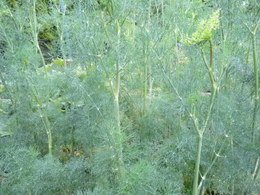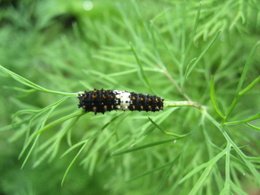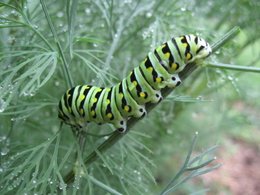Dill Growing Guide
Dill (Anethum graveolens) is an annual herb, which is in the celery family. It has attractive fern-like leaves and is an easy to grow self-seeding annual herb. Its aromatic frilly leaf sprigs are used to season fish, soups, pickles and salads.
The flowers are white to yellow arranged in a cluster called an umbel 3 to 4-inches in diameter. The attractive flowers are often used in flower arrangements. Dill seeds are edible and are a good substitute for caraway seeds and can be used to flavor breads and pickles.
Soil Preparation
Dill likes a nice loose well-drained garden soil. Add compost and blend in before planting. It prefers full sun, but can tolerate some light shade, especially during the hot summer weather. Soil pH should be 5.5 to 6.5.
Planting Dill
Dill does not transplant very well and should be direct sown in a sunny location that receives 6 to 8-hours of sunlight.
A good time to plant is just after your last expected frost. Germination takes 7 to 21-days.
Follow the directions in the seed packet. Sow dill seeds 1/8 to 1/4-inch deep and thin 8 to 12-inches apart. To avoid damaging the roots of neighboring plants the best way to thin is to snip the plant off at the soil level.
Dill is one of the host plants of Black Swallowtail butterflies and is a good addition to your herb garden as well as a flower garden or wildlife garden. Plant it in a northern location or along the sides so it does not shade other plants.
It will reach a height of 3 to 4-feet and should be planted in an area that is sheltered from high winds. Tomato cages or stakes will help keep them from being blown over.
For more detailed information visit the seed starting page.
Succession Planting
As the plant matures it starts to produce flowers, which will then go to seed. When this happens the frilly leaf stalks lose their aromatic flavor qualities. To keep a flavorful supply coming, try planting more every 2 to 3-weeks to insure that you have a fresh supply.
Leave some dill in place to let the seeds mature to save for next year.
Watering and Care
When the plants are a few inches tall add a nice loose mulch of shredded leaves or pine straw to shade the plant roots. This will keep the weeds out, the soil cooler and help retain moisture. Keep the mulch a couple of inches away from the stem. During dry spells give some water each week.
Harvesting Dill
Since dill self-seeds you most likely will find young seedlings growing in various places in your garden, hence it is often called dill weed. They are easy to recognize by the fern like leaves. Any dill that is not where you want it can be pulled up and the leaves can be added to a salad or other dish. If you planted a patch they can be thinned out 8 to 12-inches apart.
Seeds can be harvested when they turn brown and are ripe. The easiest way is to cut the seed head from the stalk. Hold the seed head upside down inside a large paper bag or a 5-gallon bucket and give the seed head a good shake, hitting the sides of the bag or bucket. The viable ripe seeds will fall off. Any stems or other debris can be picked out by hand.
The seeds have a flavor and aroma similar to caraway seeds. They look different than caraway seeds, but can be used as a substitute for caraway seeds.
Drying Dill
Dill leaves can be easily preserved by drying. When you dry your excess that you grow during the summer months you can enjoy and have a steady supply during the winter and spring.
There are several methods of drying the leaves. If you are in a warm, dry, low humidity location, you can dry the leaves in the sun or in a dry barn or a shed. A very good method of drying leaves is using a food dehydrator following your unit’s directions. Check occasionally for dryness, which may take several hours. When the leaves are brittle and crumbly when you press on them, they are done.
For most gardeners the easiest and fastest way is to dry in the oven. Pick your leaves after the dew has dried. To avoid having to remove the dried stems after drying, it is easier to cut them off before drying. Discard any discolored or bruised leaves. The leaves should be dry before putting in the oven. Place a thin layer of leaves on a parchment lined cookie sheet and place in the oven at a very low temperature setting. Leave the door slightly open.
If the temperature is too high, the leaves may turn brown. Keeping the temperature around 200-degrees F or slightly lower, your dried dill leaves will have nice green color. When dried, the leaves will be brittle and crumbly when you press on them. Check occasionally for dryness. The time it takes may be an hour or so depending on temperature and the amount of dill leaves you are drying.
When the dill leaves are fully dried, they can be stored in a tightly sealed Mason jar.
Popular Varieties
Popular varieties: Bouquet, Elephant, Fernleaf, Hera, Mammoth.
Sources: Seeds Now, Burpee, Johnny's Selected Seeds.
Diseases and Pests
Dill is deer resistant and is generally free of diseases and pests. Occasionally if dill is too crowded downy mildew, powdery mildew and aphids may occur.
It is one of the host plants of Black Swallowtail butterflies and is a good addition to your herb garden as well as a flower garden or wildlife garden. Other host plants include carrots, parsley, fennel, and Queen Anne’s lace. Plant some extra dill for the caterpillars; they do not do much damage, so leave them alone and enjoy them.
A newly hatched caterpillar is black with a white saddle around its middle and looks very much like a bird dropping. They are very small and you may not notice it until it gets to be 1/8 to 1/4-inch long. As it grows it will shed its skin and turn into an attractive stripped caterpillar.
Each molting stage is called an instar and it will go through 5-instars getting larger each time. Then it will leave the dill and attach itself to a twig where it will enter the chrysalis stage looking very much like a part of the twig.
In 2 to 3-weeks a beautiful Black Swallowtail butterfly will emerge. There are some amazing YouTube videos of the process.
The first instar of the Black Swallowtail caterpillar.
The later stage of the Black Swallowtail caterpillar.
Tips and Warnings
Dill is reported to be a good companion plant for asparagus, basil, corn, cucumbers, onion, lettuce, and vegetables in the cabbage family.
It is a poor companion plant for carrots and tomatoes. It will easily cross-pollinate with fennel and they should not be planted near each other.
For a continuous supply plant more dill seeds every 2 to 3-weeks.
Garden Spikes newsletters give you timely information once or twice a month. Subscribe Free to the Garden Times newsletter below.
Your email address will only be used to send you a newsletter and will never be sold. You can unsubscribe at any time.



